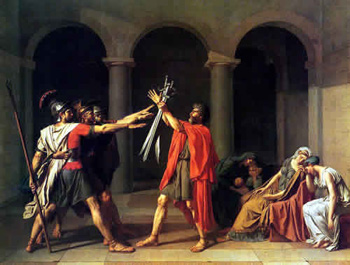| Search Art Prints | ||||||||||||||||||||
| Search Artists | ||||||||||||||||||||

|
||||||||||||||||||||
|
|
|||||||||||||||||||

The Oath of the Horatii

|
‘The Oath of the Horatii’ is an oil on canvas painting created by Jacques-Louis David in 1784, when he was commissioned by the Administrator of Royal Residences. The painting displays a scene from Roman legend with the Horatii brothers, representing Rome, saluting their loyalty and patriotism before waging war against the Curatii brothers, representing Alba Longa, to settle the conflict between the two states. To the bottom right of the painting, their mothers and sisters are stricken with fear for the warrior’s lives. According to the legend, one of the Horatii sisters was engaged to one of the Curatii brothers. Upon hearing that her brother Publius had killed her beloved, she wept with grief. Seeing her tears, Publius stabbed his sister stating, “So perish any Roman woman who mourns the enemy.”
Analysis and Reviews
“The Oath of the Horatii is the first masterpiece of a new style breaking with the rococo style. The composition is broad and simple, with the life-size figures arranged in a frieze in the foreground, as on Roman sarcophagi and Greek vases. The figures are separated by large empty spaces in a stage-like area shown head-on. David emphasizes the room's geometry. The harsh, slanting light gives the figures their relief, and their contrasting characters are conveyed using different forms. He (Jacques-Louis David) gives the men energetic bodies constructed out of straight lines and dresses them in vivid colors, while the women are all sinous curves and muted colors. The painting became the model throughout Europe for the new style of painting later known as neoclassicism.” (Musée du Louvre, Paris)
Many priests, cardinals, royalty, and even the Pope himself came to see ‘The Oath of the Horatii’. It was so well received that when the painting was poorly displayed in the Academy, after Jacques-Louis David requested it be hung in Paris’ Salon, public out roar necessitated its move to a better location. Today, ‘The Oath of the Horatii’ is displayed in the Musée du Louvre, Paris, France.











